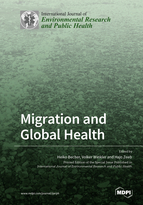Migration and Global Health
A special issue of International Journal of Environmental Research and Public Health (ISSN 1660-4601). This special issue belongs to the section "Global Health".
Deadline for manuscript submissions: closed (30 September 2021) | Viewed by 39077
Special Issue Editors
Interests: social epidemiology; migrant research; stroke; cancer; statistical methods in epidemiology
Special Issues, Collections and Topics in MDPI journals
Interests: migrant health; non-communicable diseases; low- and middle-income countries
Interests: migrant research; radiation epidemiology
Special Issues, Collections and Topics in MDPI journals
Special Issue Information
Dear Colleagues,
The recent years have witnessed a substantial increase in scientific research on migration-related topics, including health. Numerous large population-based cohort studies have been implemented mainly in Europe and North America, and these studies usually include individuals with a migration background. Therefore, these cohorts allow a comparison to the autochthonous population with respect to chronic disease risk, genetic predispositions, epigenetic aspects, and preventive aspects including health literacy, health service use, and others. While these perspectives are critical to understand and improve the health situation of migrants in their host countries, the relationship between migration and health remains complex. Migration can increase health risks but also improve the health and wellbeing of the migrants themselves and that of their family members “left behind”. Today’s migration-related research often neglects the perspectives regarding the countries of origin and lower income countries.
This Special Issue of IJERPH focuses on research and experiences related to the broad topic of migration and health while recognizing its complexity. Results based on cohort studies are particularly welcome. Researchers and practitioners from social epidemiology, genetic epidemiology, public health, healthcare research, management, quality assurance, epidemiology, health economics, and other related disciplines are invited to submit high-quality original research manuscripts and systematic reviews related to the issues in this research area.
Prof. Dr. Heiko Becher
Prof. Dr. Volker Winkler
Prof. Dr. Hajo Zeeb
Guest Editors
Manuscript Submission Information
Manuscripts should be submitted online at www.mdpi.com by registering and logging in to this website. Once you are registered, click here to go to the submission form. Manuscripts can be submitted until the deadline. All submissions that pass pre-check are peer-reviewed. Accepted papers will be published continuously in the journal (as soon as accepted) and will be listed together on the special issue website. Research articles, review articles as well as short communications are invited. For planned papers, a title and short abstract (about 100 words) can be sent to the Editorial Office for announcement on this website.
Submitted manuscripts should not have been published previously, nor be under consideration for publication elsewhere (except conference proceedings papers). All manuscripts are thoroughly refereed through a single-blind peer-review process. A guide for authors and other relevant information for submission of manuscripts is available on the Instructions for Authors page. International Journal of Environmental Research and Public Health is an international peer-reviewed open access monthly journal published by MDPI.
Please visit the Instructions for Authors page before submitting a manuscript. The Article Processing Charge (APC) for publication in this open access journal is 2500 CHF (Swiss Francs). Submitted papers should be well formatted and use good English. Authors may use MDPI's English editing service prior to publication or during author revisions.
Keywords
- migrants
- refugees
- people left behind
- cohort studies
- social sciences
- social epidemiology
- healthcare research








